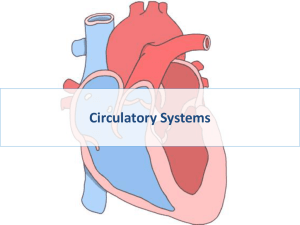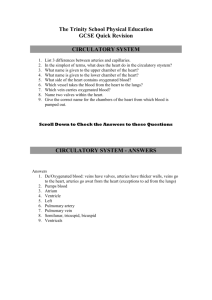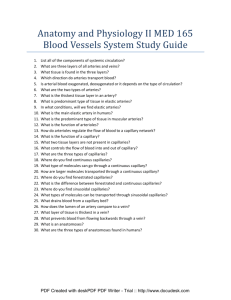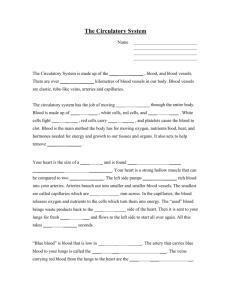IB 3 Circulation
advertisement
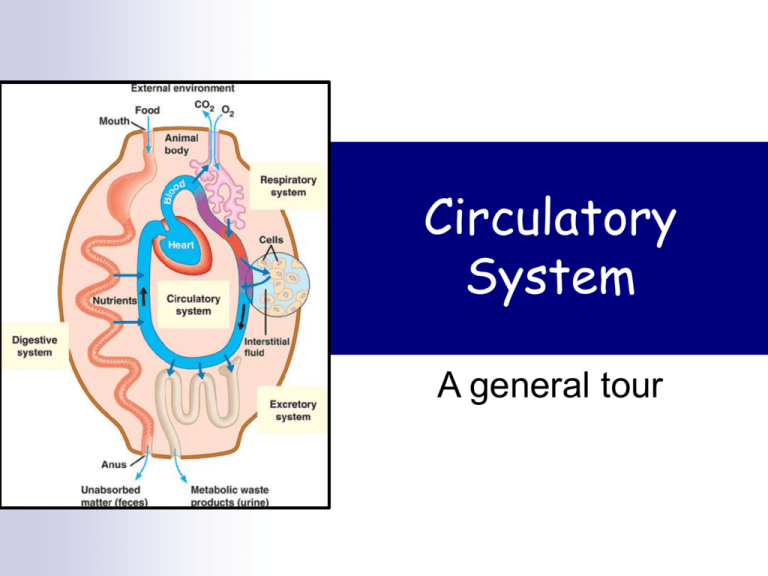
Circulatory System A general tour Exchange of materials Animal cells exchange material across their cell membrane Fuel for energy Nutrients Oxygen Waste (urea, CO2) If you are a 1-cell organism, this is easy! Diffusion If you are multicellular, it becomes more difficult Overcoming limitations of diffusion Diffusion is not adequate for moving material across more than 1-cell barrier So … set up a “highway” CO2 CO2 system to NH3 NH3 aa CO2 transport materials! NH3 O2 CH aa CO2 CHO CO2 O2 NH3 aa CHO CH O2 aa NH3 CO2 NH3 CO2 NH3 NH3 CO2 CH CO2 NH3 CO2 aa O2 CHO CO2 aa In circulation … What needs to be transported? Nutrients & fuels From digestive system Respiratory O2 & CO2 from & to gas exchange systems: lungs/gills Intracellular Water, salts, nitrogenous wastes (urea) Protective agents Immune defenses waste Waste products from cells gases White blood cells & antibodies Blood clotting agents Regulatory molecules hormones Circulatory systems All animals have: Circulatory fluid = “blood” Tubes = blood vessels Muscular pump = heart open hemolymph closed blood Vertebrate cardiovascular system Chambered heart Atria = receive blood Ventricles = pump out blood Blood vessels Arteries = carry blood away from heart Arterioles Veins = return blood to heart Venules Capillaries = thin wall, exchange/diffusion with cells Capillary beds = networks of capillaries Blood vessels arteries arterioles capillaries venules veins Arteries: built for high pressure pump Thick walls Provide strength for high pressure pumping of blood (80-120 mm Hg) Narrow diameter/lumen Elasticity Elastic recoil helps maintain blood pressure even when heart relaxes Middle layer = elastin Outer layer = collagen No valves No exchange with cells Veins: built for low pressure flow Thinner walls Wider diameter/lumen Blood travels back to heart at low velocity & pressure Lower pressure (<10 mm Hg) Distant from heart Blood must flow by skeletal muscle contractions when we move Squeeze blood through veins Valves In larger veins, one-way valves allow blood to flow only toward the heart No exchange with cells Capillaries: built for exchange Very thin walls Lack 2 outer walls Only endothelium Enhances exchange across capillary Diffusion Exchange occurs between blood & cells No valves Some capillaries have pores Fenestrations Allows plasma & certain other cells/molecules to “leak” into tissue Controlling blood flow to tissues Blood flow in capillaries controlled by precapillary sphincters Supply varies as blood is needed After a meal, blood supply to digestive tract increases During strenuous exercise, blood is diverted from digestive tract to skeletal muscles Capillaries in brain, heart, kidneys & liver usually filled to capacity Why? sphincters open sphincters closed Exchange across capillary walls Fluid & solutes flows out of capillaries to tissues due to blood pressure Lymphatic capillary Interstitial fluid flows back into capillaries due to osmosis plasma proteins osmotic pressure in capillary “bulk flow” BP > OP BP < OP Interstitial fluid What about edema? Blood flow 85% fluid returns to capillaries Capillary Arteriole 15% fluid returns via lymph Venule Lymphatic system Parallel circulatory system Transports white blood cells Defends against infection Collects interstitial fluid & returns to blood Maintains volume & protein concentration of blood Drains into circulatory system near junction of vena cava & right atrium Lymphatic system Production & transport of WBCs Traps foreign invaders lymph vessels (intertwined amongst blood vessels) lymph node Mammalian circulation systemic pulmonary systemic What do blue vs. red areas represent? Mammalian heart to neck & head & arms Arteries that supply blood specifically to the heart Coronary arteries Coronary arteries bypass surgery Heart valves 4 valves in the heart Flaps of connective tissue Prevent backflow Atrioventricular (AV) valves Between atrium & ventricle Keeps blood from flowing back into atria when ventricles contract Tricuspid & bicuspid/mitral valves Semilunar valves Between ventricle & artery Prevents backflow from arteries into ventricles while they are relaxing Aortic & pulmonary valves Pulmonary Artery Aorta Pulmonary Vein Vena Cava Right Atrium Left Atrium Pulmonary valve Aortic valve Mitral valve Tricuspid valve Right Ventricle Left Ventricle Septum Our circulatory system is a double circulatory system. Lungs the right side of the left side of the system the system deals with deals with oxygenated deoxygenated blood. blood. Body cells pulmonary artery pulmonary vein lungs head & arms aorta main vein Right Left liver digestive system kidneys legs What about blood? There are 4 main components to blood: Erythrocytes Red blood cells Oxygen transport Leukocytes White blood cells Non-specific immunity Lymphocytes Specific immunity Platelets Blood clotting Plasma Fluid medium Red blood cells a biconcave disc that is round and flat without a nucleus contain hemoglobin, a molecule specially designed to hold oxygen and carry it to cells that need it. can change shape to an amazing extent, without breaking, as it squeezes single file through the capillaries. White blood cells there are many different types and all contain a big nucleus. the two main ones are the lymphocytes and the macrophages. macrophages ‘eat’ and digest microorganisms . some lymphocytes fight disease by making antibodies to destroy invaders by dissolving them. other lymphocytes make antitoxins to break down poisons. Platelets Platelets are bits of cell broken off larger cells. Platelets produce tiny fibrinogen fibres to form a net. This net traps other blood cells to form a blood clot. Blood clotting Damaged cells release chemical signals called clotting factors Clotting factors convert prothrombin (zymogen) into thrombin Thrombin converts fibrinogen into fibrin Stops blood flow & helps prevent pathogens from entering Clotting factors cause platelets to become sticky, resulting in a clot at the injury site Plasma Also contains: Carbon A strawcoloured liquid that carries the cells and the platelets which help blood clot. dioxide Glucose Amino acids Proteins Minerals Vitamins Antibodies Hormones Waste (like urea) Heat Atherosclerosis Hardening & narrowing of the arteries Due to deposit of plaque High blood pressure damages artery wall Causes chronic inflammation Accumulation of lipids, cholesterol, debris & calcium Fatty deposits (atheromas) reduce diameter of lumen (stenosis) and elasticity of the artery May lead to the formation of clots & blockages in the artery Major cause of heart attacks, strokes, and peripheral vascular disease Atherosclerosis Risk factors for coronary heart disease Lack of exercise Diet Obesity Genetics Gender Males at greater risk due to low estrogen levels Smoking Nicotine causes vasoconstriction Increases blood pressure Age Bloody well ask some questions, already!
